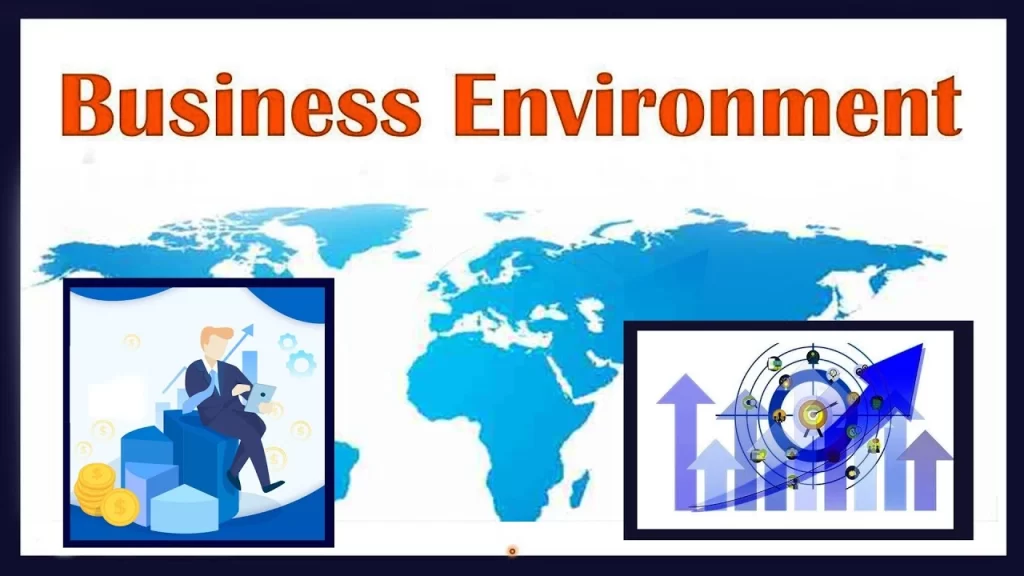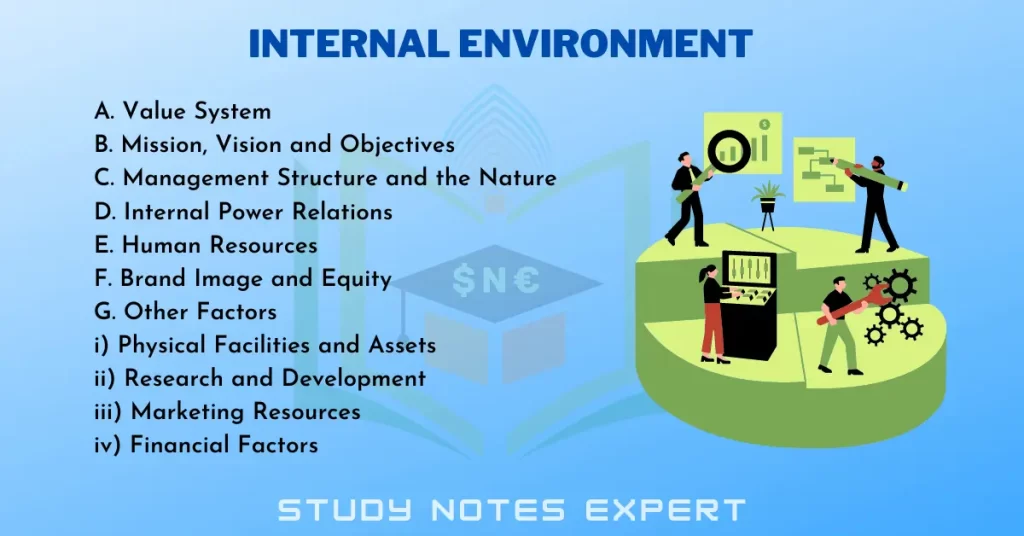A thorough understanding of the surroundings and the changes it brings is essential for companies. Companies that scan their surroundings and are ready to adjust to changes could be successful. However, businesses that fail to adapt to their surroundings will not last long. In this blog, we will discuss the types of business environment and the points that exist in all type of business.
Types of Business Environment
The types of business environment are:
1. Internal Environment
2. External Environment

1. External Environment
External business environments are all the elements outside the company’s control. These factors that affect an organization are also uncontrollable, such as socio-cultural and economic factors, demographic and technological aspects, legal issues, and other factors.
External influences are beyond the control of businesses. Thus, a company’s success heavily depends on its ability to effectively adjust and design the internal variables. It allows the company to take advantage of opportunities and overcome challenges in the business surroundings. However, every business has two kinds of environments, i.e., the external environment and the internal environment.
The external environment consists of two essential components:
A. Micro Environment
B. Macro Environment

A. Micro Environment
A micro business environment is a term used to describe the elements that directly impact the efficiency of the business. It means that they represent the immediate environment that a company affects. The microelements comprise suppliers, competitors, marketers, intermediaries in marketing consumers, suppliers, and the general public—macro factors of the business world influence these variables.
The microenvironmental aspects are more closely in connection with the business in contrast to macro factors. The micro environmental factors affect various industries in various ways. So, a company can employ the micro-factors used for a specific business. For instance, the microenvironment of a restaurant could be its patrons, other restaurants, and suppliers of raw materials and human resources, for example.
The success or demise of a business depends on how it handles the micro-elements that makeup:
i) Customers
The most vital element of a business external environment. The primary goal for any company is to retain and attract its customers. It will help the company achieve long-term survival and financial success. To increase customer loyalty, companies must be attentive to the requirements and desires of their customers and meet these needs efficiently. Businesses must examine customers’ evolving preferences and tastes and adapt their products and services to these changes. Every company should know the client’s interest, as it could negatively impact the business environment.
ii) Suppliers
They supply raw materials, parts, and equipment to business companies. Suppliers are a crucial micro-factor in the business external environment context. They need to be reliable and friendly with businesses. It will assist the company in meeting customers’ expectations, and businesses will be free to carry the responsibility of storing large stocks.
iii) Marketing Intermediaries
These are the ones who act as mediators between the producer and the customer. The number of intermediaries in marketing differs based on the size and nature of the distribution system. Marketing intermediaries benefit the company only when they can coordinate between channels without obstacles, as these are the external environment components.
iv) Competitors
Organizations that produce similar products and attempt to take over market share are called competitors. The business needs to be aware of what competitors are doing and develop a future strategy to increase profits and remain in the market. It allows the company to stay ahead of its competitors over the long term.
V) The General Public
The public is also an integral aspect of the business external environment climate. The people’s opinions and reactions directly affect a company’s image. It can also impact the revenue and sales of the business. Activities like polluting the air, noise, the absence of waste disposal, and so on. could negatively impact the company’s image.
B. Macro Environment
The macro environment is prevalent outside of the business. The company must implement numerous production, marketing, and management changes based on macroeconomic factors.
The macro-environmental factors that are most significant are in the following order:
i) Politics
Factors like the state political institutions, government, legislation, and private and public stakeholders’ policies impact the business climate and the external environment. The company’s stability and success depend on the political environment in which it operates. Sometimes, the changes done by the government’s policies (e.g., tax policies, government contracts, etc.), as well as regulations (e.g., safety regulations) and regulations (e.g., safety regulations), affect the smooth operation and efficiency of the company.
ii) Economic Environment
The conditions of a nation’s economy can affect an organization’s business plans and decisions. Factors like the economic growth rate, unemployment rate, foreign exchange rates, and inflation and deflation rates can cause or contribute to problems when managing your business. It affects the external environment related to the business.
iii) Social Environment
The social environment is the norms and beliefs of society. Businesses are in influence by factors like the evolving preferences and tastes of the customers as well as the standard of living and the level of education. For instance, the advertisement phrase “Come to life” was employed by Pepsi Cola Company to promote its product. Pepsi-Cola Company to promote its development. The message has misunderstood by the people living in a specific area. They saw “Come Live” as “Coming out of Graves.” In the end, there was no demand for the product in that area. The company, therefore, changed its name because it was impossible to thrive in the market without recognizing societal norms and the external environment.
iv) Technology Environment
It’s the evolution of the operation of a business, such as the making use of new equipment, advanced technologies and improved production methods, and so on. The company must monitor these modifications to stay competitive in the market—technology advances to aid the business in offering standard and high-quality products to customers.
v) Physical Environment
In the short-term and long-term, the concerns of environmental impacts are vital to the business. External environmental changes such as natural catastrophes could affect general business operations, such as supply and production, destruction of assets owned by the company, etc. The methods for assessing risk to the environment to deal with such scenarios are in use by companies.
vi) Legal Environment
Every business transaction must govern specific laws and regulations. The business cannot afford to ignore legal issues, affecting how it conducts business. An appropriate legal framework is vital for any business. Some of the most important laws that impact businesses are the Essential Commodity Act, Weights and Measures Act, Trade Mark Act, and others.
vii) Demographic Environment
Demographic changes majorly impact business decision-making. The demographics vary from one location to another. The external environment changes could be in the population size or age, ethnicity composition, income levels, etc. Before determining a plan for the future and present business, it is essential to consider these factors related to demographics.
viii) The Global Environmental
The global business environment comprises a variety of political and legal structures. Also, economic policies, standardization of accounting, standards for environmental protection, and labour policies includes in it. These deal with cultural and language differences, trade and import regulations, foreign exchange policy, tariffs, trade agreements, etc. Each of these elements could have significant differences between countries. The goals of a company and methods of achieving these goals are the main determinants of its activities in an international environment of business.
2. Internal Environment
An environment that directly affects the business is the internal environment. The external factors that influence the business’s climate can control. Thus, factors like physical facilities and organizational and functional tools can be modified and revised according to the demands of the business environment. The following internal elements determine the strategies and choices of the internal organization:

A. Value System
The choice of a business’s mission, vision, and goals, as well as business policies and procedures, are all part of the system of value of a company. The internal environment consists of a company’s founding, and the management team is vital in making decisions for the values system.
B. Mission, Vision and Objectives
Vision is a broader vision of the company’s internal environment’s future possibilities. Vision assists in meeting the business’s goals. The mission is a short-term process.
C. The Management Structure and the Nature
In general, the organization’s structure influences the business decision-making process. This structure comprises directors on a board, managers, executives, and so on. The number of people in a network defines the time of the decision-making process.
D. Internal Power Relations
The coordination of the different levels of organizational structure is crucial. Three levels, i.e., the top, middle and lowest, must have a typical relationship. It allows the company to run efficiently.
E. Human Resources
Human resources are the main element of any company’s internal environment. They determine the strengths and weaknesses of an organisation. The fundamental requirements for human resources are the ability to perform, quality dedication and sincerity, positive behavior, etc.
F. Brand Image and Equity
An enterprise’s internal environment influences the image it projects to the outside market. The idea of an organization aids in raising capital, mergers and other alliances, etc. In the same way, brand equity affects the company.
G. Other Factors
Many other variables affect how successful or unsuccessful an enterprise is in the following order:
i) Physical Facilities and Assets
These internal environment factors are crucial to the company’s efficiency. Facilities that affect the company’s competitiveness are production, technology, and labour, among others.
ii) Research and Development
The ability to invent and be competitive is in explanation through the R&D department within an organisation. But it’s an external element. It also affects the corporate environment.
iii) Marketing Resources
The marketing effectiveness of an organisation directly influences the resources like the marketing department of the business and the marketing team, distribution channel, and brand equity.
iv) Financial Factors
The financial aspect is the lifeblood of an organization. Proper distribution of economic resources impacts business performance, as well as strategies and policies for business. The most significant factors influencing the external environment include financial policies and capital investment.
Conclusion
In conclusion, the enterprise surroundings are complex and dynamic, and businesses must continuously monitor and adapt to its diverse factors to thrive in the long term. By knowledge and leveraging the inner and outside factors that affect their operations, agencies can function strategically, make informed choices, and capture possibilities for growth.
What are the 2 Types of Business Environment?
There are two main types of business environment. 1. Internal Environment 2. External Environment. These are further classified into categories.
What is meant by External Environment?
External environment consists of all the factors that are not in the control of any business enterprise. These factors are uncontrollable and affects the enterprise in a different manner. It includes economic environment, technological environment, demographic environment, physical environment, etc.

